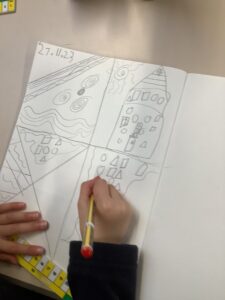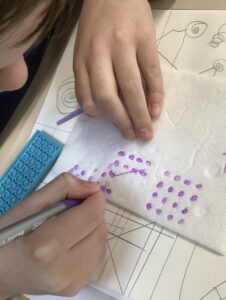It’s been freezing indoors and outdoors this week!
This week in Science, 2C had a fantastic time learning about freezing and melting. We are Chemists this half term and this week, we learnt about water.
We know that water is a liquid but when it reaches freezing point (0 degrees celsius), it turns into ice. Ice is a solid.
When ice heats up, it melts and turns into a liquid, water.
One of our experiments involved placing a cube of ice in our hands and watching it change state. The ice went from a solid to a liquid after some time.
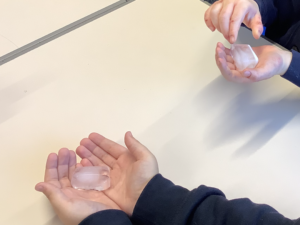
Our next experiment included trying to melt a block of ice containing a small toy. We used four different methods. We used a hairdryer, a hot water bottle, water and a towel.
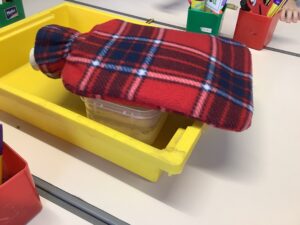

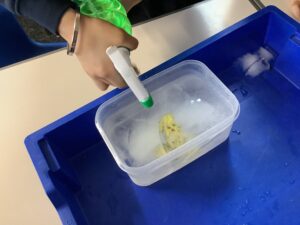
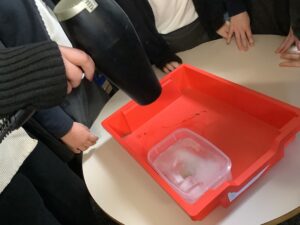
We found out that the hair dryer was most effective in melting the ice and freeing the toy because it produced the most heat. The towel took the longest because it emitted the least amount of heat.
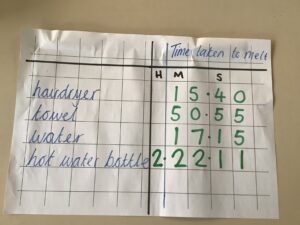
Help at home: by freezing and melting ice and discussing how the heat and cold help change the properties of water.
3,4C Class News
What a busy week of learning!
In addition to our usual lessons this week, we have had some exciting events taking place.
On Monday, we enjoyed a skipping session led by Skipping School. We learned some new skipping skills and had the chance to practise.
We have been busy getting ready for our class assembly which was a complete success yesterday. It was so good to see many adults coming to watch us – thank you and we hope you enjoyed it. A huge ‘well done’ to everyone in 3,4C – we were very proud of you.
This morning, we enjoyed an author and illustrator zoom with Pippa Goodhart and Nick Sharratt as they launched their new book ‘You Choose Christmas’. It was entertaining and we had a go at drawing our own illustrations.
Please continue to help at home by reading regularly and accessing TT Rock Stars regularly with your child.
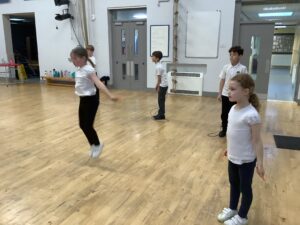

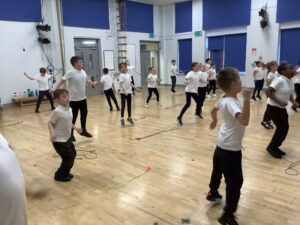
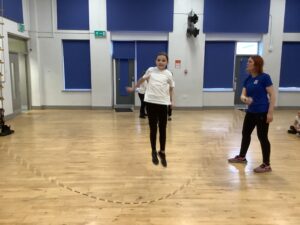
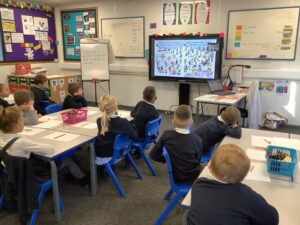
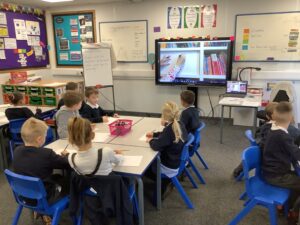
3,4A and 5,6C – Writing
Following Mr Lindsay’s previous post, here are a few more pictures of the children sharing and editing their writing together.
In 3,4, we had written narratives and had focused on including expanded noun phrases, similes and prepositions.
Help at home by asking your child if they can tell you what these things mean! Can they give you any examples?
Art – creating printing plates
All the year 1 and 2 classes have been exploring line, pattern and shapes in our Arty Ideas books. Some of the inspiration has come from our visit to The Hepworth Wakefield and from looking at the work of Paul Klee.
We used pencils, pens and lots of other things around the classroom to make the marks on our polystyrene printing plates.
Shared writing 56C and 34A
Year 5/6C had the pleasure of sharing their writing with Year 3/4A. Children picked out improvements that they noticed:
- use of fronted adverbials
- a range of ambitious vocabulary
- some figurative language



1A Art
Last week, Class 1A went on a school trip to The Hepworth Gallery in Wakefield. We set off on the bus which was super charged with lots of the children’s favourite tunes. The journey was full of singing, laughter and wonder as to what the day would hold.
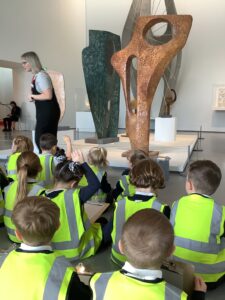
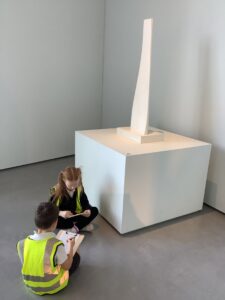
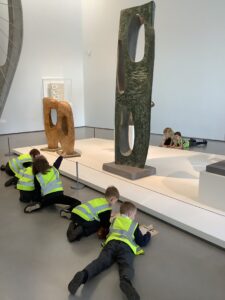

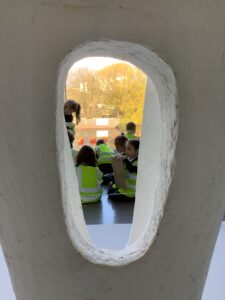
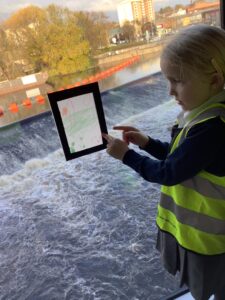

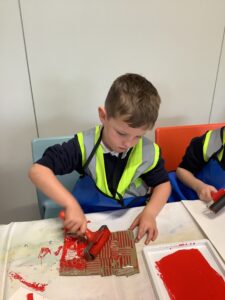
The morning
When we arrived, we were greeted by the friendly staff and we were introduced to our workshop artist. We started the day by exploring one of the galleries. The artist gave us a natural object and we needed to find a sculpture which represented it in some way. We were asked to draw the sculpture on tracing paper. Next, we observed real nature through the giant window and we were given another piece of tracing paper to draw the patterns that we could see. We placed one on top of the other, framed them and held them up against the window to see how the light accentuated the layers and colours in the work. After that, we headed downstairs to start creating our very own collagraphs with a range of materials. Mrs Brown was so impressed with our focus, concentration and creativity! We used rollers to roll ink onto the collagraph and then carefully placed paper on top before rolling with a dry roller to create a print. We repeated the process with a different colour on top. They looked absolutely incredible!
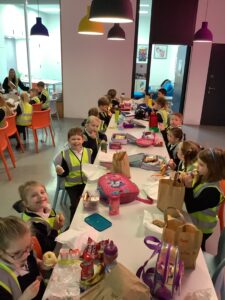
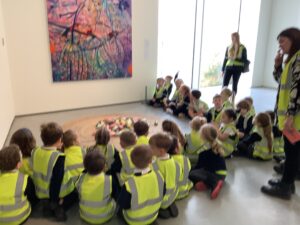
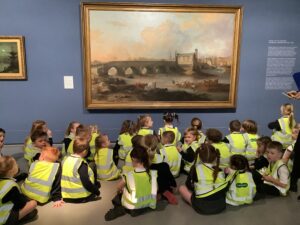
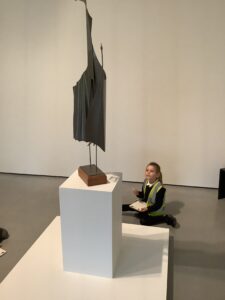
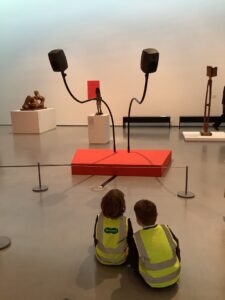
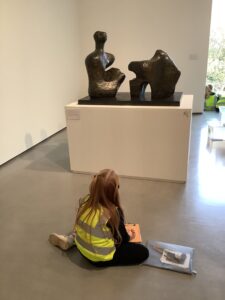
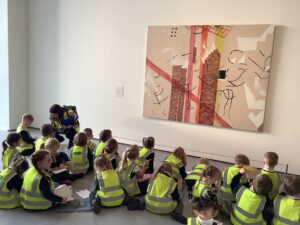
The afternoon
After a spot of lunch, we explored the outdoor sculpture garden and then we explored all the other indoor galleries. We discussed what we saw along the way. Looking at some large pieces of art in silence helped us to keep discovering new things in them. In the abstract art, we observed the lines, patterns and colours and thought about what it would be like to be Katie from the James Mayhew stories and enter some of the paintings. We looked with wonder at the abstract art and thought about what they might represent. One gallery had a sound installation and we wondered around to the noises and noticed how the sculptures seemed to change before our eyes as we moved around them.

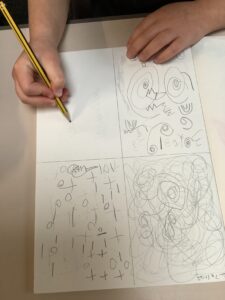
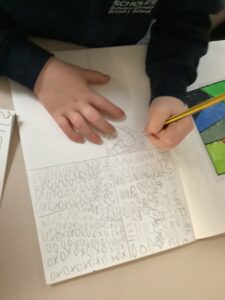
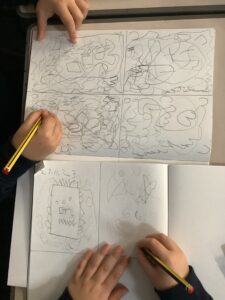
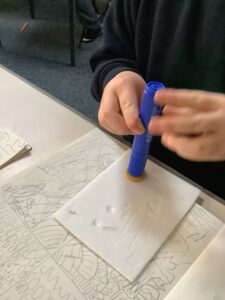
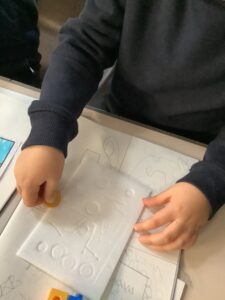
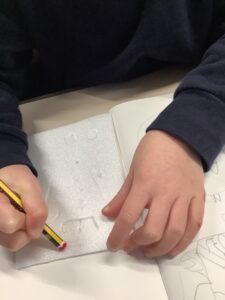
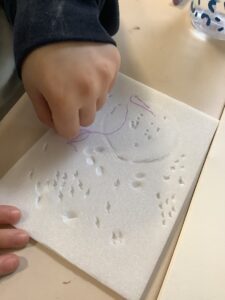
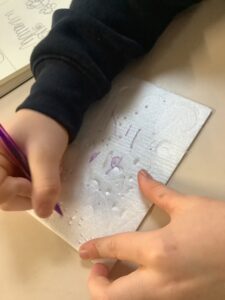
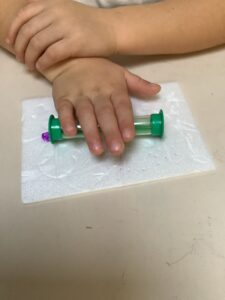
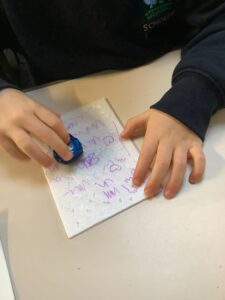
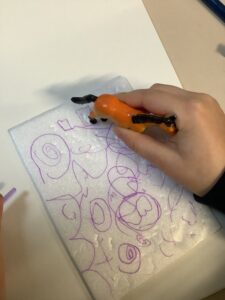
This week in school, our art journey continued. We looked at and and talked about different pieces of Paul Klee’s work. We used his works as inspiration to create designs using lots of different lines (curved, straight, short, long, thin, curly, light, hard.) After that, we used our favourite lines on polystyrene tiles to explore and experiment what their effect would be. Some children suggested using their nails or objects from around the classroom and we tried them out by pressing and pushing them into the tile noticing similarities and differences in the lines they created.
Help at home – You could look at pictures in books, photographs or a paused frame on the television to notice and talk about the types of lines, shapes, tones and textures that you can see.
We are artists!
As part of our art topic, we’ve been looking at art from before and after the start of the twentieth century. The children were able to sort images into these two categories. To challenge themselves further, they then created a timeline of art. Which was the earliest piece and how could they tell? The children applied their art vocabulary brilliantly.
Help at home – Can you search for some artists online? Can your child discuss the artwork using their art vocabulary?


Gymnastics: jumping
In this week’s gymnastics session, we practised our jumping.
We made sure we bent our knees at the start and end of the jump, used our arms to help us jump up and made sure our landings (on two feet) were controlled.
We practised three different types of jumps:
1. a normal jump


2. a tuck jump

3. a straddle jump

Next week, we’ll continue jumping and practise star jumps and turn jumps.
Help at home: See if your child can remember all the different types of jumps from our learning. Can they show you what they look like?
Living and Learning – I can talk about my feelings
This week in Living and Learning, our focus is on feelings and our mental wellbeing. We read a text about what mental health is and how we can look after our mental health. This can include activities that we like or spending time with family and friends.
We also looked at lots of different scenarios we may experience in our lives and how this would make us feel.



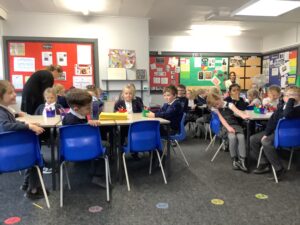


We know that we are all entitled to feel however we feel and that is okay. We also know what signs to look after in others, and how to be empathetic towards others.
Help at home: by encouraging your child to express their feelings often and talk about different types of emotions.
Day and Night
This week in our light and dark topic, we’ve been learning about day and night.
Night Monkey, Day Monkey
We’ve been reading Night Monkey, Day Monkey by Julia Donaldson.

The story follows two monkeys who find themselves awake at their opposite times of day. They are very confused by what they see and need help understanding everything! Our word of the week is: nocturnal. We know that nocturnal means “active at night”
We’ve been writing about nocturnal animals and features of day/night.

Science: shadows
We’ve been making further investigations into shadows, by spotting them outside and by using our dark tent. We know that to make a shadow, we need a source of light. When that source of light is blocked, it casts a shadow. We explored using mirrors to reflect lights differently and used colour paddles to change the colour being projected onto the tent wall.
Outside, the sun is light- Albie S
The shadow is made ’cause I put my hand there- Reggie
When the torch is closer to my hand it’s bigger (the shadow) … it’s smaller far away- Dawson
Look- yellow (colour paddle) makes it look like the sun!- Heidi

Maths; part-whole
In Maths, we’ve been looking at the ‘parts’ that make the whole of something. For example, the parts of us that make our whole body. Our head, eyes, legs etc. are the parts, our body is the whole.
This leads on to understanding the composition of number; the parts that can be added together to make a whole number.
The children were introduced to a part-part-whole model and how objects can be used with it, to explore the parts of a number.

PE; Gymnastics
This half term, Friday PE sessions are gymnastics. We are exploring movement and balance, developing fundamental skills and learning how to demonstrate our skills to others.

Living and learning; e-safety
This week’s living and learning statement is: I know how important it is to make careful choices when online
The key message in Reception is to tell a trusted adult when something happens online that feels unsafe or unusual. Also, that internet use should be monitored by an adult. We also spoke about why we should limit screen time, for our health.
We watched and listened to the story of Smartie the Penguin
The story gives examples of different scenarios that could happen online and has a song that runs throughout, that reminds children what to do:
Before you tap and click,
You need to stop and think,
and TELL SOMEONE!

Phonics
Autumn 2 week 3 has focused on the single letter phoneme z and digraphs zz, qu, ch
We’ve learnt the tricky words; go, no, to, into
Tricky words are words that should be read by sight.
In provision, we’ve been playing what’s in the box and writing the words to match pictures we find.

In the reading area, we’ve been tricky word detectives. We’ve been finding a ‘tricky word of the day’ in books and taking a picture of them with an iPad.


Poetry Picnic
Each week we will be learning a new poem. We will recite this poem each day. By saying the poem out loud, we can focus on the sounds and rhythm of each word or line. We talk to the children about how this can help us become better readers. This week’s poem is called Shoes

We talk about how a poem sometimes has rhyming words and sometimes doesn’t. We also talk about how a poem can have a fast rhythm or a slow rhythm.
Click below to watch Reception recite this week’s poem!
Help at home; Stars
Next week, we’ll be looking to the skies again! We are learning about the night sky and stars.
We know this is a topic of interest for many children in Reception. If you have any books or resources to share that are linked to this topic, we would love to see them.
Christmas production
We’ve had a few questions about our upcoming Christmas production. The dates of which can be found on the school calendar (homepage).
This week, the children have chosen the part they would like to play. There are some speaking and some non-speaking roles. Children had the option to choose from either of these.
We will shortly be sending home the parts they have chosen, costume suggestions and lines to learn (for those who have them)
Let the festivities begin!!!




